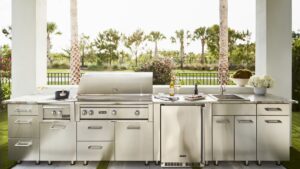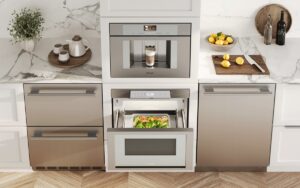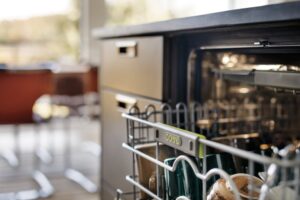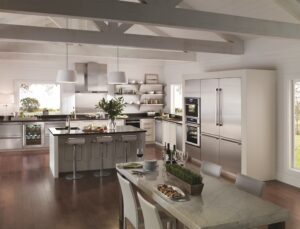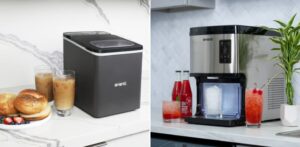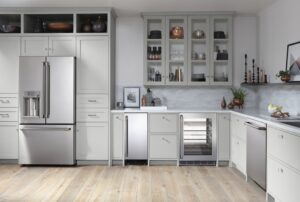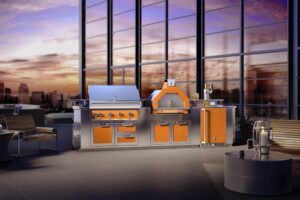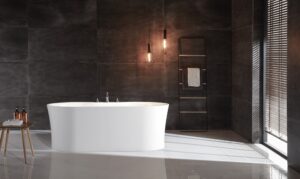Blog
Displaying 1 - 1 of 0 Articles
Categories
-
AppliancesOctober 22, 2025
The Ultimate Outdoor Grill Guide for 2025: Built-In vs. Freestanding
In Southern California, outdoor living is not just a trend, it’s a lifestyle. As homeowners design their spaces, they include the outdoor areas for weekend cookouts and evening gatherings during the summer time. The grill is the most important part of every outdoor kitchen. As we enter 2025, many buyers designing their backyards face a key decision: built-in vs freestanding grill. There are advantages to each style, and buyers will need to consider how they will be using the grill. Built-ins are designed to blend seamlessly with the rest of the outdoor kitchen, but freestanding grills offer more flexibility and mobility. This outdoor grill guide 2025 will cover the most important differences and features to consider, as well as the most premium brands available. Universal Appliance and Kitchen Center’s Outdoor Living experts will help you choose the luxury outdoor grill in Los Angeles, whether you are looking to create a new backyard design or upgrade your existing setup. Why Outdoor Grilling is Bigger Than Ever in 2025 More families in Southern California are embracing the outdoor kitchen trend 2025. The Southern California climate permits families to enjoy their yards all year. Families enjoy warm afternoons, cool evenings, and mild winters, so it becomes natural for families to cook outside. Families do not just grill in the summer, but year-round. Having a high-end grill in your backyard is no longer a luxury; it is an absolute necessity. A luxury grill Southern California families choose is capable of accommodating both small family![84-The Ultimate Outdoor Grill Guide for 2025 84-The Ultimate Outdoor Grill Guide for 2025]()
-
AppliancesOctober 01, 2025
Smart Bathroom Faucets & Fixtures in 2025: Blending Technology with Luxury Design
Bathrooms are becoming more than just functional spaces. Design and innovation are taking center stage. Connected fixtures and smart bathroom faucets in 2025 changing the way we go about our daily routines. With the advent of touchless faucets, which makes it possible to avoid contact with faucets and reduce the spread of germs, as well as the digital showers which can be programmed to provide endless spa-like comfort, bathrooms are becoming more convenient and hygienic. Luxury bathroom technology promotes eco-friendliness. Sustainability is achieved through water saving aerators and smart technology that automatically shut-off flow. These smart bathroom fixtures also come in decorative finishes, including matte black and brushed gold. To see these innovations in person, check out the decorative plumbing and hardware collection at Universal Appliance and Kitchen Center. Why Smart Fixtures Matter in 2025 In 2025, bathrooms are designed with comfort, health, and sustainability in mind, moving beyond mere functionality. That is why smart bathroom faucet and fixtures becomes a ‘must’ and a style statement for modern living. Hygiene Comes First One of the biggest smart bathroom benefits is the reduced spread of germs. Touchless taps and self-cleaning surfaces make shared spaces much safer for families and guests. Everyday Convenience Digital features let homeowners modify the temperature, flow, and even program routines and schedules which offer smoother and calmer mornings and evenings. Designed for Sustainability With water-saving features, like aerators, automatic shut-off, and flow tracking, smart fixtures keep California’s eco-conscious lifestyle and luxurious design in perfect harmony. Blending Function![80-Smart Bathroom Faucets _ Fixtures in 2025 80-Smart Bathroom Faucets _ Fixtures in 2025]()
-
AppliancesSeptember 17, 2025
Built-In Coffee Machines: Are They Worth It for Your Kitchen in 2025?
Having a built-in coffee machine adds a coffee shop feel to your home and morning routine. With a single touch, espresso, cappuccinos, and lattes can be served in seconds. They also meld with your kitchen design. For remodels and design-focused upgrades, a built-in espresso maker is a stylish and handy addition. As with everything, there are some trade-offs to consider. These systems have a higher initial cost, need a professional to install them, and require regular maintenance to keep them in their best condition. However, for most Los Angeles homeowners, the daily convenience of a coffee system 2025 makes it a worthwhile investment. To determine whether it’s the right fit for you or not, Universal Appliance and Kitchen Center offers an in-person exploration for built-in coffee systems, and for the rest of our readers, this guide has everything you need to know about coffee systems such as cabinet fit, water options, grinders, milk systems, cleaning, smart features, and brand comparisons so you can make the decision yourself, are built-in coffee machines worth it or not. Measure Your Cabinet Cutout Prior to selecting your model, knowing the built-in coffee dimensions will make installation seamless. Most systems are designed to fit a 24-inch coffee system cutout, which allows for pairing with wall ovens or warming drawers for a neat stacked appearance. Some brands do provide slightly larger systems, so verifying the measurements remains important. While determining the cabinet cutout for the coffee machine, do not solely work with the width. You need![76-Built-In Coffee Machines 76-Built-In Coffee Machines]()
-
AppliancesAugust 27, 2025
How to Choose the Right Dishwasher for Your Home: Noise, Capacity, and Features Explained
Picking the best dishwasher for your home can be simple. Focus on three main things: the dishwasher size that suits your household, the features you’ll actually use, and how quietly it operates. This dishwasher buying guide helps you find the perfect unit without sifting through endless specs that sound the same. These choices really matter because the right dishwasher can save you time, use less water, and make the mess of cleanup way easier. Whether you want flexible racks, smart controls, or simply want sparkling dishes every time, knowing how to choose a dishwasher turns the purchase into a smart long-term investment. If you are looking for the best dishwasher of 2025, start to explore the Universal Appliance and Kitchen Center’s dishwasher collection or visit our showroom to see top dishwasher brands, try out features, and get personalized advice for your kitchen. Measure Your Space Before buying a new dishwasher, it’s a must to measure your kitchen space so your new appliance slides in with no hassle. The standard dishwasher size is about 24 inches wide, 24 inches deep, and 35 inches tall, but smaller kitchens have more choices. An 18-inch-wide compact model fits well in small kitchens or apartments, and pull-out drawer styles are perfect when every inch counts. If a built-in does not work, a portable dishwasher on wheels is a handy option. Use this checklist when you measure for a new dishwasher space to ensure a smooth installation: Width: Measure cabinet to cabinet at the top and bottom.![CU Cove open middle rack CU Cove open middle rack]()
-
AppliancesAugust 06, 2025
Top 5 Kitchen Appliance Colors and Finishes for 2025 (And How to Match Your Style)
Appliances are no longer limited to fulfilling their core functions. They contribute significantly to the style of the kitchen. Because colors and finishes set the mood and tie the design together, they are also a major contributor towards the kitchen's and home's resale value. There is a notable shift in 2025 appliance trends, and stainless steel finishes are being replaced with more creative and design-conscious choices. Matte finishes, like black, white glass, and brushed brass, are gaining popularity among homeowners seeking to enhance their kitchens. This kitchen appliance color guide will walk you through how to match your appliances with modern, farmhouse, or any style in between. By following these appliance finish trends, you will be able to make informed decisions regarding an ageless yet fashionable look. Classic Stainless Steel (Still a Top Contender) There are certain trends that never go out of style, and one of them is stainless steel appliances. They are a reliable choice for most homeowners. With a clean and neutral look, stainless steel blends with any design. This flexibility makes stainless ideal for both new builds and remodels, especially if you want a style that will stand the test of time. Stainless steel appliances are easy to clean because they are resistant to stains and scratches. Furthermore, you can get appliances made of stainless steel from different categories, including a refrigerator or a dishwasher. Premium brands like Sub-Zero, Wolf, and Miele still retain stainless steel in their collections, which showcases its enduring charm in timeless kitchen![70-Top 5 Kitchen Appliance Colors and Finishes for 2025 70-Top 5 Kitchen Appliance Colors and Finishes for 2025]()
-
AppliancesJuly 16, 2025
Why a Countertop Ice Maker is a Must-Have for Summer Kitchen Upgrades in Southern California
In Southern California, summer means spending time outside, having relaxed evenings, and entertaining with family and friends. These gatherings, whether they are family barbecues or poolside parties, require ice to keep everyone cool and hydrated. With a countertop ice maker, you can have ice on hand whenever you need it for beverages, smoothies, or a quick refresh. If you are considering summer kitchen upgrade, it’s one of the most affordable and convenient additions you can have. Say goodbye to frantic store runs for ice, or finding melted ice trays from the freezer. Explore stylish and high-performing ice makers that can completely change the way you entertain and stay refreshed during the summer at Universal Appliance and Kitchen Center, one of the best Los Angeles appliance stores. Why Countertop Ice Makers Are Trending in 2025 How people hydrate and entertain at home is shifting and ice maker trend in 2025is indicative of this change. These small appliances have gained immense popularity. Previously people used ice trays, or bought bags of ice from the store, but modern homeowners value convenience, style, and reliability. A countertop ice maker is perfect as it offers instant ice on demand, which is great for summer gatherings, smoothies, and iced coffee lovers. Social media has sparked new trends that influenced families to buy home bar and coffee stations. Families that follow wellness trends prefer having chilled water and healthy drinks readily available. On the other hand, people who like to entertain appreciate having plenty of ice available![69-Why a Countertop Ice Maker is a Must-Have for Summer Kitchen Upgrades in Southern California 69-Why a Countertop Ice Maker is a Must-Have for Summer Kitchen Upgrades in Southern California]()
-
AppliancesJuly 08, 2025
How to Remove Scratches from Stainless Steel Luxury Appliances
High-end stainless steel appliances look sleek, but they can scratch more easily than you might think. A rough sponge, or a small fumble with a pot, can leave marks that dull the finish of your fridge, oven, or dishwasher. For homeowners who love a polished kitchen, those little scratches can be a big annoyance. The good news is that many of the scratches on stainless steel surfaces are easy to repair at home. With a little time and the right supplies, you can remove the scratches and restore that bright finish without buying a new appliance. For scratches that go a little deeper, there are gentle treatment options to try, and experts who can make it look like new again. In this guide from Universal Appliance and Kitchen Center, we show you how to remove scratches from stainless steel, when you can safely do it yourself, and how to repair stainless steel appliances with confidence. Plus, you’ll get luxury appliance care tips for keeping your luxury appliances looking brand new for years to come. What Causes Scratches on Stainless Steel Appliances? Even the most careful cooks can end up with scratches on stainless steel appliances. Here are the everyday actions that can be the stainless steel scratch causes and lead to appliance surface damage: Jewelry, belt buckles, or coat buttons rubbing the surface while moving around the kitchen Abrasive tools, like steel wool or tough sponges, used to scrub stubborn spots Kids’ toys or placing/removing magnets from the refrigerator door![91865_006_CafeStainlessKitchen.psd 91865_006_CafeStainlessKitchen.psd]()
-
AppliancesJuly 07, 2025
When Is the Best Time to Buy Appliances? Your 2025 Buying Guide
Should I wait for a sale or buy it now? If you’re updating your kitchen or replacing a worn-out appliance, you’ve probably asked yourself this more than once. Understanding the best time to buy appliances can save you cash without sacrificing quality or the latest features. High-end appliances can really make a home shine, but the price tags can make you wince. In 2025, knowing when to buy can help your wallet breathe a little easier. Whether you’re curious about appliance sales in 2025 or just wondering when to buy kitchen appliances, timing your purchase perfectly can unlock savings and a wider selection. In this simple guide from Universal Appliance and Kitchen Center, we’ll cover seasonal sales, when new models hit the market, and a few expert tips. Our goal is to help you shop smarter so each dollar goes a little farther. Best Times of Year to Buy Appliances If you’re getting ready to remodel or replace aging appliances, choosing the right time to buy can help you save a lot. Stick to the right appliance sales calendar and you can upgrade to premium models without blowing your budget. End of the Year: October to December The last three months of the year are one of the smartest times to shop for big appliances. Starting in October and running through December, most retailers and manufacturers work to clear existing stock to make space for the newer models arriving in January. If you’ve been wondering when to buy a fridge,![65-When Is the Best Time to Buy Appliances 65-When Is the Best Time to Buy Appliances]()
-
AppliancesJuly 01, 2025
The Ultimate Guide to Outdoor Beer Dispensers: Elevate Your Backyard Entertaining in 2025
Backyard entertaining has significantly evolved from simple grills and folding chairs. Homeowners are now building entire outdoor kitchens that integrate seamlessly with the home, and even include pizza ovens and wine coolers. One of the latest must-have additions is an outdoor beer dispenser. This is a game-changer for anyone who loves hosting gatherings. No need to run in and out of the house for drinks or to drag a cooler filled with ice, you will be able to pour a fresh cold beer right off the tap in your backyard. Latest outdoor beer dispensers make serving drinks easy and bring a touch of elegance to your home. If you need backyard entertaining ideas, a beer dispenser is a great place to start. This guide will help you plan a brand-new luxury outdoor kitchen in 2025 or upgrade an existing one. It will also help you understand how beer dispensers work, what to look for when buying one, and why Hestan is leading the way in outdoor living. What Is an Outdoor Beer Dispenser? If you are designing a backyard bar or an outdoor kitchen, you may heard a buzz about what a kegerator is. An outdoor beer dispenser, also known as an outdoor kegerator, is a specialized appliance that serves cold beer on tap and can withstand the outdoor environment. In 2025, many people are also wondering how a beer dispenser works. It has a CO₂ system for carbonating the beer, a cooling unit for chilling it, and a tap![The Ultimate Guide to Outdoor Beer Dispensers The Ultimate Guide to Outdoor Beer Dispensers]()
-
Plumbing FixturesJune 30, 2025
Choosing the Perfect Bathtub: Freestanding vs. Built-In Styles for a Luxury Bathroom
Selecting the perfect bathtub is one of the most crucial decisions when planning a bathroom remodel. In a custom home, a tub isn’t just a part of the bathroom furniture where you bathe; it’s an addition that comes with style, comfort, and value. Whether you’re remodeling or building from scratch, the decision has to be freestanding vs built-in tub. Design intent and function consequence are what separates one from the other, and the ability to see that distinction is what truly sets each decision apart. A luxury bathtub could help turn your bathroom into a personal sanctuary. But when you consider the range of categories, materials, and installation types, choosing a bathtub for a bathroom remodel can be a bit overwhelming. In this article, we will discuss all the essential information regarding built-in vs freestanding tubs to help you understand the space, plumbing, and design flexibility regarding both tub types. Having this information can help you choose a bathtub that fits your layout and meets your design style. Freestanding Bathtubs: The Statement Piece A freestanding bathtub serves as the focal point for many luxury bathrooms. Unlike built-in options, these tubs stand alone, giving them a sculptural look that adds grace and charm to the space. These tubs are ideal for homeowners who want a spa-like experience at home. Freestanding tubs are not fixed to a wall, so they provide more layout options and can be placed in the center of the bathroom, near a large window, or positioned at an![Choosing the Perfect Bathtub Choosing the Perfect Bathtub]()
Displaying 1 - 1 of 0 Articles


